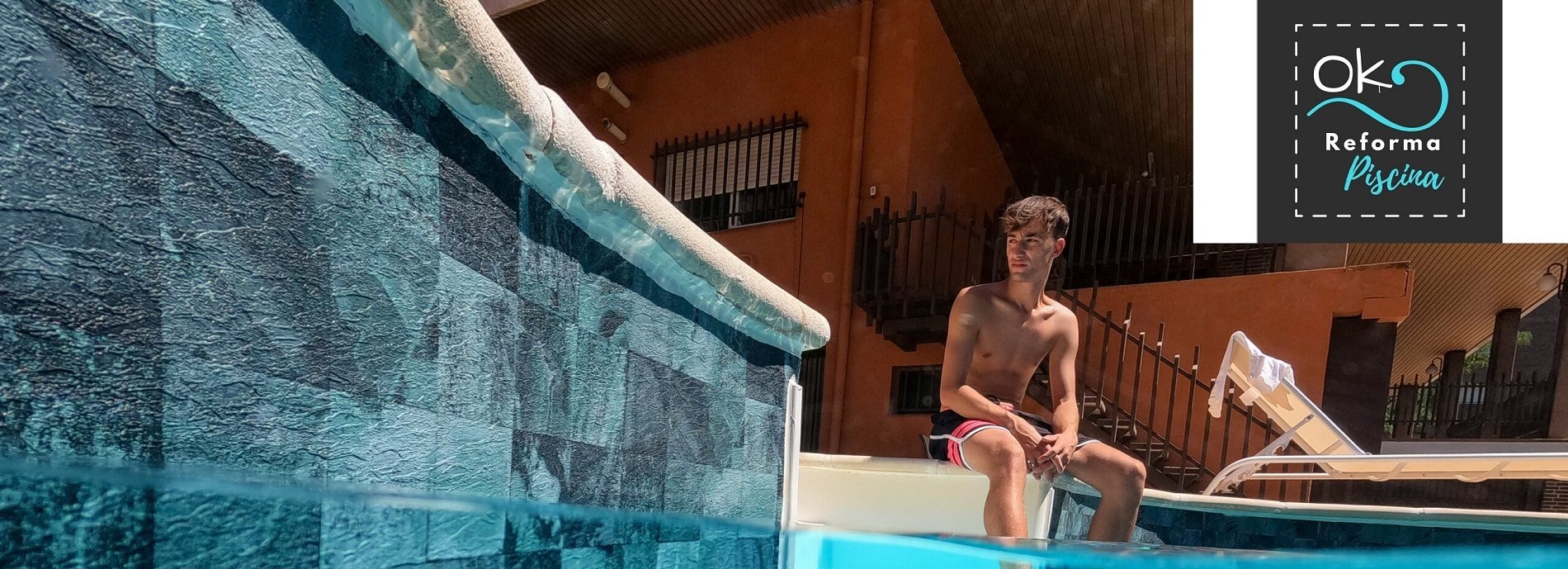
Table of contents of the page
En Ok Pool Reform We present you a solution within Pool equipment and from the section of Climatized pool To heat your pool water: Pool heat exchanger.
What is a pool heat exchanger?

Pool heat exchanger
The gas heating system uses the burning gas to heat a heat exchange mechanism with water.
It is a type of heating suitable for small pools, or as an auxiliary heating system that has up to 150 m³.
Heat Exchangers use, for example, natural gas from the boiler, propane gas or fuel oil to heat the pool water. A water circuit is established in which the pool water passes through the boiler, is heated, and subsequently returns to the pool.
What is a heat exchanger
Next, in this video they answer the following questions: What is a shell and tube type heat exchanger? “Helmet or shell” due to its cylindrical body and “tubes” for the internal parts that make it up.
Video heat exchangers
Analysis of the heat exchanger for swimming pools

Advantages of pool heat exchanger
Pool exchanger virtues
- Water can be heated in any weather situation, gas is simply needed as fuel.
- It is a very safe system, since the equipment has a safety device that if the flame goes out, the gas is automatically turned off.
Disadvantages of pool heat exchanger
Pool exchanger cons
- For this type of heater it is necessary to install a gas central and always maintain it, such as a gas shower or a stove, for example.
- The coil has a short, since it oxidizes, due to chlorine and fire.
- Using fossil fuels to heat pool water is the highest cost way.
- This type of heating is recommended only for small pools.
How a pool heat exchanger works
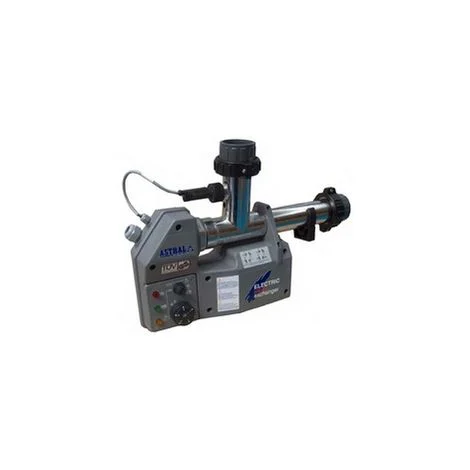
Heat transfer theory

The natural laws of physics always allow conduction energy in a system to flow until equilibrium is reached.
For this reason, heat leaves the hotter body or hotter fluid, whenever there is a temperature difference, and is transferred to the cold medium. A heat exchanger follows this principle in its effort to achieve equalization.
With a plate-type heat exchanger, heat penetrates the surface, which separates the hot medium from the cold medium very easily.
Therefore, it is possible to heat or cool fluids or gases that have minimum energy levels.
The theory of heat transfer from one medium to another, or from one fluid to another, is determined by several basic rules:
- Heat will always transfer from a hot medium to a cold medium.
- There must always be a temperature difference between the media.
- The heat lost by the hot medium is equal to the amount of heat gained by the cold medium, except for losses to the surroundings.
What is a heat exchanger?

A heat exchanger is equipment that continuously transfers heat from one medium to another.
There are two main types of heat exchangers: direct and indirect.
- Direct heat exchanger, where both media are in direct contact with each other. It is assumed that the media do not mix. An example of this type of heat exchanger is a cooling tower, where water is cooled through direct contact with air.
- Indirect heat exchanger, where both media are separated by a wall through which heat is transferred.
Indirect heat exchangers are available in several main types (plate, shell and tube, spiral, etc.) In most cases, the plate type is the most efficient heat exchanger. In general, it offers the best solution to thermal problems, providing the widest pressure and temperature limits within the constraint of current equipment.
Pool exchanger operation
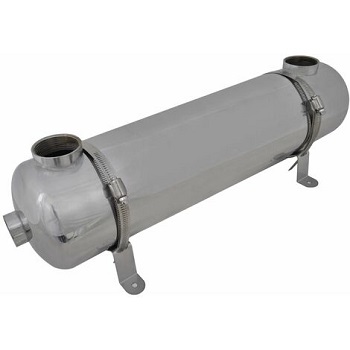
To use a pool heat exchanger, two conditions are imperative:
- Have a boiler;
- This boiler should be close to the technical room and the swimming pool.
The technology of the boiler is indifferent. Whether it is an oil or gas boiler or a heat pump, you can use it to power the heat exchanger. However, it is advisable to ensure that this power is sufficient. If you heat your pool only when the heat is off, then your boiler may be large enough. But this point must be checked if what you want is to heat your pool when the domestic heating is on, as in the case of an indoor pool.
The proximity of the technical room and the boiler is mandatory if you do not want to encounter significant losses. Ideally, they should be in the same place to optimize the passage of calories.
Heat exchanger compatibility
Device compatible with all types of pool heating systems
- This device is compatible with all types of heating systems domestic (heat pump, boiler, geothermal and solar). In fact, heat exchangers work with any energy source, including renewables such as solar or geothermal.
- With it you can keep your pool water at an ideal temperature throughout the year.
- Furthermore, a heat exchanger is the most efficient way to air condition a pool. Therefore, it represents a savings in economic costs for the owner of the facility, by allowing him to correctly manage his energy consumption.
U-tube heat exchanger parts

How to choose a heat exchanger for the pool
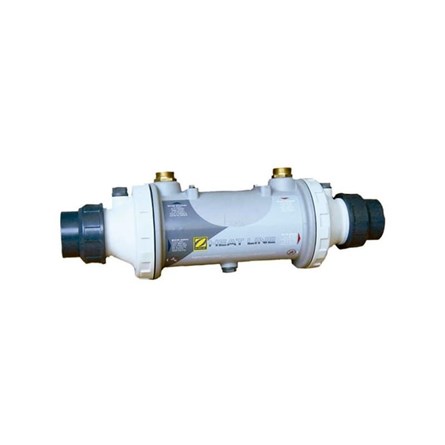
General criteria for choosing a heat exchanger for swimming pools
Generic perspectives to evaluate to properly choose a pool exchanger
- PREMIUM QUALITY
- Caudal
- Power
- Volume of water
- If you use saline electrolysis as a disinfectant
How to determine the dimensions of a pool heat exchanger
La power thermal heat exchanger required varies depending on the size of the pool and the rise time to the desired temperature. In general, the heat exchanger is Calculate so that it increases 10ºC in two days.
The following table allows you to calculate the minimum of your heat exchanger. The power of the heat exchanger determines the volume and consumption, as well as its purchase price.
If you want to refine your search, the following formula will give you the intermediate values:
P in kW = Volume in m3 x 1.4 x DeltaT/T.
T It is the time in which you want your pool to reach the desired temperature, DeltaT It is the difference between the initial temperature of the pool water and the desired temperature. This way, you can do your calculations, but without being too demanding.
Oversizing the pool heat exchanger will imply a supplement in the purchase cost while once the temperature reaches the desired point, the heating power to stabilize will be lower.
A large inground pool will not need to reach the desired temperature in 2 days. However, a small above ground pool that is used occasionally will need to be heated quickly.
Important: The power of the heat exchanger is given as a function of the temperature of the water at the entrance to the primary circuit. This temperature varies depending on your central heating. A boiler emits a temperature in the primary circuit that is higher than that of a heat pump.
Normally, a boiler reaches 90°C in the primary while a heat pump provides water at 45°C. Furthermore, if you want to connect a heat pump, make sure that the exchanger is adapted to the temperature of your primary network.
Other criteria to take into account when choosing your pool heat exchanger
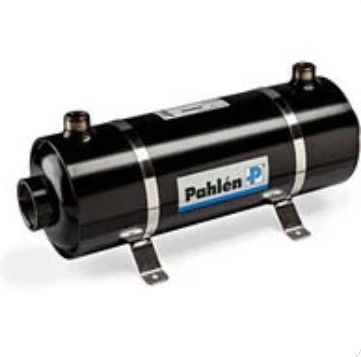
Pool thermal heat exchangers need a minimum flow. It is necessary to ensure that there is a compatibility between boiler and exchanger circulator.
This flow should not exceed a maximum value. Es requiredTherefore, the installation of a bypass.+
More tips to choose your heat exchanger well
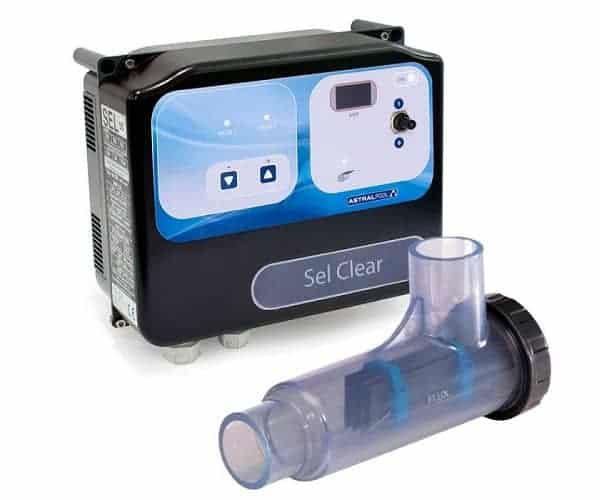
If you use electrolysis as a disinfectant, or have a sea water pool, tubes or heat exchanger plates they must be by force of titanium, which withstands the chemical attacks of pool water more than stainless steel.
Pool heat exchangers are sold with or without the circulator. Check if your installation requires the presence of a circulator. This is more likely if you are going to use the boiler for home and pool heating at the same time. All this will depend on your installation and your connections.
Not all pool heat exchangers have a thermostat. If you can, opt for a model that has it.
Last tip: Since the thermal heat exchanger involves a modification to your central heating installation, you must be very cautious and carefully consult the instructions for your boiler or heat pump.
To finish, click on the following link to know all the details of: What is salt chlorination, types of Saline Electrolysis equipment and difference with chlorine treatment. At the same time, we will also discuss different topics of saline electrolysis: advice, tips, differences, etc. on the types and varieties of existing salt chlorinator equipment.
Different types of pool heat exchanger

There are two main types of pool thermal heat exchangers:
- tube or tubular heat exchangers, where heat transmission is achieved through the wall of the tube;
- plate heat exchangers, where the exchanger is made up of parallel and radial plates in which one of them is intended for the primary circuit and the other for the secondary circuit.
At the same power, the tube exchangers are generally less expensive and less bulky that plate exchangers, which have the advantage of working at a lower primary temperature, which favors installations with heat pumps.
Imagine a pool that does not drop below 27ºC... Now you can have it! If your central heating is near your pool, the heat exchanger is made for you. In addition to having simple installation and a good price, it will also allow you to quickly raise the temperature of your pool. What are you waiting for?
Types of water circuits in the exchanger
Pool heat exchanger circuits
The pool heat exchanger has two water circulation circuits:
- the so-called primary circuit, which carries the water that comes from the residence's central boiler and supplies the pool with heat;
- the so-called secondary circuit, which leads the pool water to heat up.
These two circuits are parallel to the heart of the thermal heat exchanger and on this occasion the primary circuit transfers its calories to the secondary circuit.
Types of heat exchangers

Depending on the heat transmission of the exchanger, we can distinguish two different types:
1. Those of heat transfer by conduction through tube wall. This occurs when energy spreads due to collisions between particles.
2. Heat transmission by fluid convection. It consists of transporting heat through the movement of the fluid. In this case we can distinguish two types of fluids:
– Towards the inner wall of the tube
– From the external wall of the tube towards the external fluid
1st recommended model of pool heat exchanger
Waterheat Tubular Heat Exchangers

- Then, you can click the following link to get more specifications about: Tubular heat exchanger: for boilers, solar panels and heat pumps
2nd Recommended model of pool heat exchanger
Heat exchanger for pools with Titanium coil

What is the thermal exchanger for pools with a titanium coil?
Titanium coil heat exchangers are specially designed for heating hot water. Pools and Spas with high level of chlorination or high salinity.
The materials used to manufacture the coil and casing are compatible with water used in the referred applications.
The heat exchangers They are ideal for working in solar installations, given the high exchange surface and high efficiency in heat transmission.
The exchangers have supports for anchoring them to the ground, so that the device is mounted in a vertical position.
Materials Thermal exchanger for swimming pools with Titanium coil
- Heating coil: Titanium
- Housing and connection fittings housing: PVC
- Coil connection fittings: Brass
Heat exchanger installation

Place and connect the heat exchanger
How to install the heat exchanger
El heat exchanger It is placed on a fixed base, the wall, for example. It can be placed horizontally or vertically.
Regarding the connection of the heat exchanger, it is anchored to two different water circuits:
- Al filtration circuit of the pool water
- Al primary circuit of heating
- Al filtration circuit of the pool water
- Al primary circuit of heating
Horizontal installation position of heat exchanger

Pool heat exchanger vertical installation position
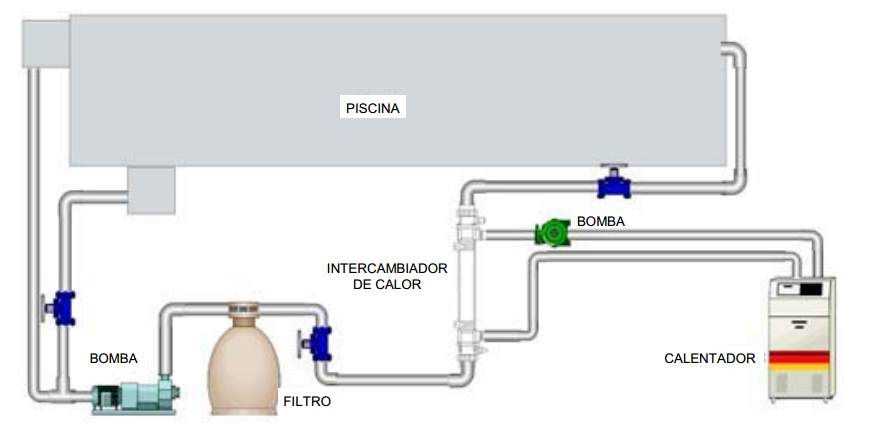
Pool heat exchanger connections
The pool heat exchanger is connected to two water circuits
Regarding the connection, the exchanger will be connected to two completely independent water circuits:
- Connection to the pool water filtration circuit: It will be placed online as follows: Heat exchanger – pool pump with filter – water treatment equipment.
- Connection to the heating (primary) circuit: It will be installed directly in the boiler (primary heating circuit).
